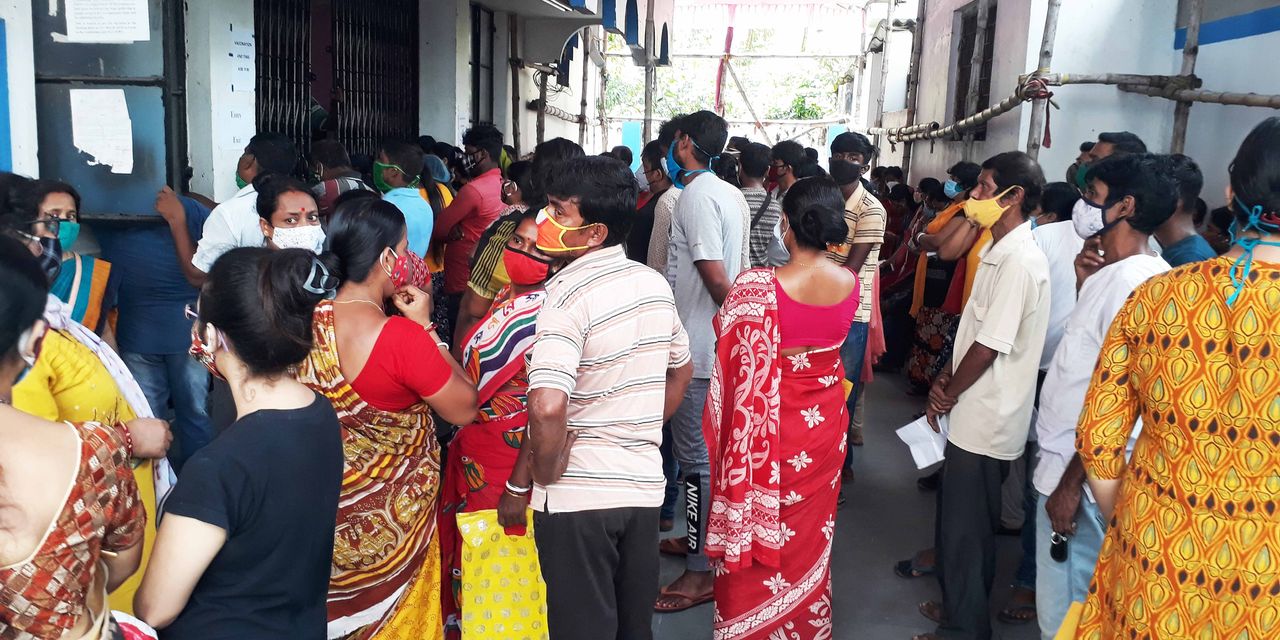India’s Covid Curve Could Raise the World’s

As India recovers from a brutal second wave of the Covid pandemic, it faces a new challenge: Can it quickly vaccinate enough people to minimize the risk of a third?
Over the first three days of this week, India jabbed 21 million people—a significant acceleration. Stepping up vaccinations, combined with protection gained from a large number of Covid infections, could carry the country toward herd immunity by year’s end. But this week’s surge in vaccinations may not be sustainable, and the duration of protection provided by previous exposure to the virus remains uncertain.
The high stakes for India are self-evident. Covid has battered the country’s economy, diminished its international standing, and raised serious questions about its government’s competence. Officially, about 392,000 Indians had died of Covid as of Wednesday. But many experts say that figure is a gross underestimate.
India’s battle against the disease also matters disproportionately to the global effort against Covid. The longer the virus continues to spread, the more variants can emerge, and a nation with one-sixth of the world’s population is a potentially huge incubator.
The highly contagious Delta variant sweeping the world was first detected in India. This mutation has already led to an uptick in cases in the U.K. and is set to become the dominant strain in the U.S. This week, White House chief medical adviser Anthony Fauci said the Delta variant is the “greatest threat” to eliminating Covid in America. He expects the strain to be “quite dominant” in the U.S. within several weeks to a month. The longer India’s vaccination effort takes, the higher the odds of other variants emerging there, including some that may be immune to current vaccines.
“It’s safe to say that India is the most important challenge that we know of in the world today,” says Jerome Kim, director general of the International Vaccine Institute, in a phone interview. “So far we’ve been lucky, but a vaccine-resistant mutant could undermine $18 billion worth of U.S. government investment in vaccines.”
India’s troubles have also set back vaccination efforts in other poor countries. As the world’s largest manufacturer of vaccines, India had been poised to supply the World Health Organization with hundreds of millions of doses earmarked for the developing world. But since March India has diverted vaccine supplies to its domestic market. After coming under attack for an ill-judged vaccine-diplomacy effort that critics say gave priority to global grandstanding over citizens’ health, New Delhi will be loath to resume exports until India’s own population is inoculated.
It’s easy to be skeptical about India’s prospects. The best India has done before this month was 84 million Covid vaccinations in April, on average 2.8 million shots a day. As of Wednesday, only 3.7% of India’s 1.4 billion people were fully vaccinated. About 17.5% had received one dose of vaccine.
In a phone interview, Gagandeep Kang, a virologist at the Christian Medical College in Tamil Nadu, points out that historically the bulk of Indian vaccination efforts have been aimed at children or pregnant women. Reaching all adults poses a new challenge. She also worries about “huge resistance” to vaccination in rural areas rife with ill-founded rumors about the dangers the shots present. Dr. Kang estimates that India does not yet have sufficient vaccine production to consistently vaccinate even four million people a day. She doesn’t expect the country to start administering eight million to 10 million doses a day before the end of the year.
It’s unlikely that international help can cover the gap. Dr. Kim expects global supplies to remain constrained for at least the next three to six months. Should people need booster shots or fresh vaccinations for variants, global demand could reach 30 billion doses over the next two years. To put this in perspective, so far about 2.79 billion doses have been administered across the world.
Nor does New Delhi’s response to the pandemic so far inspire confidence. In an email interview, T. Jacob John, an Indian virologist, says the Indian government’s response to the pandemic has been marked by a mix of “denial, [a longing for] God’s help, wishful thinking and pseudoscience.”
Unlike better-prepared nations, India failed to order sufficient vaccines in advance or boost manufacturing capacity with grants. Its haphazard pacing seems to favor appearances over reality: India made all adults eligible for vaccines almost seven weeks before Britain, despite having vaccinated a much smaller proportion of the population. A hastily approved domestic vaccine appeared to privilege vaccine nationalism over scientific rigor.
Nonetheless, there’s reason for cautious optimism. The scale of the pandemic in India—an estimated 637 million cases, according to the Seattle-based Institute for Health Metrics and Evaluation compared with the official estimate of 30 million—means that the country may already be relatively close to herd immunity.
Indian private companies have decades of experience producing vaccines. Dr. Kim believes that top Indian companies, including Pune-based Serum Institute of India and Hyderabad-based Biological E and Bharat Biotech, have the capacity to ramp up production of high-quality vaccines. A clutch of new shots will likely become available before the end of the year. The U.S. vaccine Novavax has been licensed to Serum Institute; Biological E will manufacture Johnson & Johnson’s single-shot vaccine.
There’s no question that India flubbed its management of the second wave. But with a little luck and a lot of effort, it may still dodge a repetition of this spring’s devastation.
Copyright ©2020 Dow Jones & Company, Inc. All Rights Reserved. 87990cbe856818d5eddac44c7b1cdeb8


